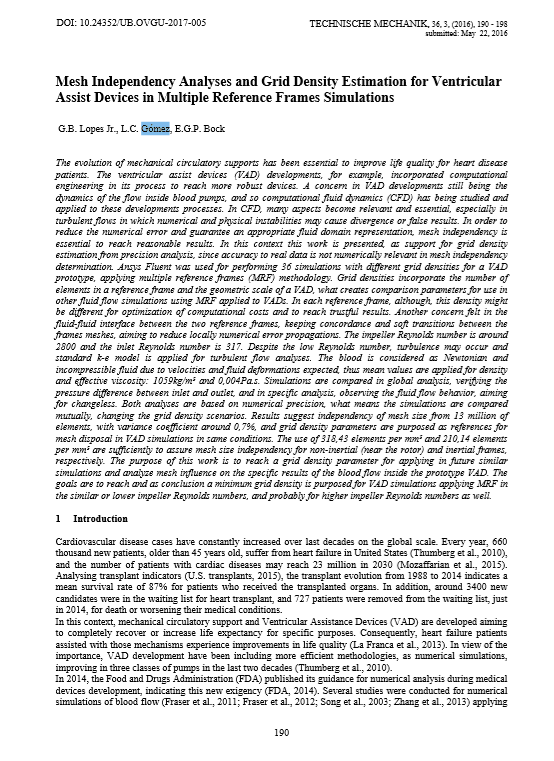Mesh Independency Analyses and Grid Density Estimation for Ventricular Assist Devices in Multiple Reference Frames Simulations
DOI:
https://doi.org/10.24352/UB.OVGU-2017-005Abstract
The evolution of mechanical circulatory supports has been essential to improve life quality for heart disease patients. The ventricular assist devices (VAD) developments, for example, incorporated computational engineering in its process to reach more robust devices. A concern in VAD developments still being the dynamics of the flow inside blood pumps, and so computational fluid dynamics (CFD) has being studied and applied to these developments processes. In CFD, many aspects become relevant and essential, especially in turbulent flows in which numerical and physical instabilities may cause divergence or false results. In order to reduce the numerical error and guarantee an appropriate fluid domain representation, mesh independency is essential to reach reasonable results. In this context this work is presented, as support for grid density estimation from precision analysis, since accuracy to real data is not numerically relevant in mesh independency determination. Ansys Fluent was used for performing 36 simulations with different grid densities for a VAD prototype, applying multiple reference frames (MRF) methodology. Grid densities incorporate the number of elements in a reference frame and the geometric scale of a VAD, what creates comparison parameters for use in other fluid flow simulations using MRF applied to VADs. In each reference frame, although, this density might be different for optimization of computational costs and to reach trustful results. Another concern felt in the fluid-fluid interface between the two reference frames, keeping concordance and soft transitions between the frames meshes, aiming to reduce locally numerical error propagations. The impeller Reynolds number is around 2800 and the inlet Reynolds number is 317. Despite the low Reynolds number, turbulence may occur and standard k-e model is applied for turbulent flow analyses. The blood is considered as Newtonian and incompressible fluid due to velocities and fluid deformations expected, thus mean values are applied for density and effective viscosity: 1059kg/m³ and 0,004Pa.s. Simulations are compared in global analysis, verifying the pressure difference between inlet and outlet, and in specific analysis, observing the fluid flow behavior, aiming for changeless. Both analyses are based on numerical precision, what means the simulations are compared mutually, changing the grid density scenarios. Results suggest independency of mesh size from 13 million of elements, with variance coefficient around 0,7%, and grid density parameters are purposed as references for mesh disposal in VAD simulations in same conditions. The use of 318,43 elements per mm³ and 210,14 elements per mm³ are sufficiently to assure mesh size independency for non-inertial (near the rotor) and inertial frames, respectively. The purpose of this work is to reach a grid density parameter for applying in future similar simulations and analyze mesh influence on the specific results of the blood flow inside the prototype VAD. The goals are to reach and as conclusion a minimum grid density is purposed for VAD simulations applying MRF in the similar or lower impeller Reynolds numbers, and probably for higher impeller Reynolds numbers as well.





